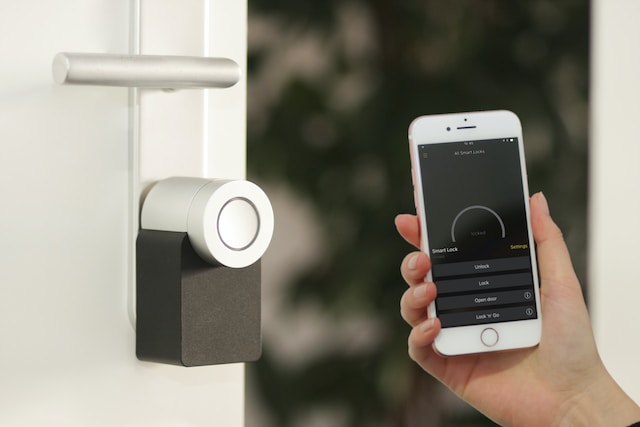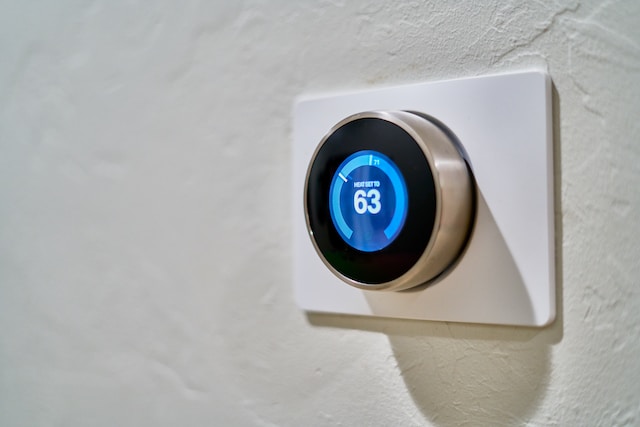
Have you considered one of those keyless smart locks for your home security? You might want to think again…
Smart home and “Internet of Things” (IoT) devices streamline many daily processes, from opening the curtains to making coffee. However, IoT devices bring a number of security threats to your front door.
What price do you need to pay for convenience? Find out as we explore 6 smart home security threats that you need to be aware of.
#1. Data breaches
The primary threat to your smart home and devices is a classic data breach. Not only can it set off a chain reaction of cyberthreats, but it also exposes real information about you.
In a breach, intruders look for Personal Identifying Information (PII). Examples of PII include:
- Social Security and passport numbers;
- Credit card and banking data;
- Your address or live location;
- Emails, logins, passwords, etc.
Safeguard you and your family’s PII with a VPN extension. VPNs work by encrypting browsing data so that the real location of your smart home stays hidden.
#2. Identity theft
A major threat after data breaches or hacks is identity theft. Scammers use your personal information to do everything from online shopping to applying for a loan in your name.
What’s worse is that you can have your identity stolen from any device. Vince Steckler, the past CEO of Avast, warned against smart coffee machines. IoT devices like these aren’t built for security, so they’re the perfect launching point for hackers.
Many smart home devices prioritize ease of use over security. As we allow these devices to link up to our networks and accounts, they threaten the entire safety of our online lives.
#3. Various cyberattacks
So far, we’ve only talked about data-related attacks, but what about the big and nasty cyberattacks? It turns out that smart home devices aren’t immune to cyber assaults and viruses.
Plenty of cyber attacks can still be perpetrated on smart home devices:
- DoS and DDoS attacks on networks;
- Phishing and spear-phishing campaigns;
- Man-In-The-Middle (MITM) attacks;
- Destructive malware in various forms.
Protect every IoT device you own with premium antivirus and firewall software to help identify suspicious behavior.
#4. Device hijacking
What’s creepier than a hacker stealing your identity through a coffee machine? Well, what about someone hijacking your entire house just to mess with you?
This is exactly what happened to an American couple in 2019 when their home was hacked. The intruder hijacked their thermostat, boiling them at a cool 90°F. Afterward, he began talking to them and playing vulgar music through a security camera in their living room.
When common cases of compromised passwords (like this one) are coupled with smart devices, hackers can easily intrude on your most private spaces.

#5. Physical security breaches
I know this sounds like a nightmare, but that’s only because IT IS. That’s right — if you have a smart lock, a hacker could walk right into your home! Unfortunately, this threat is only too real once you’ve connected your home security to the internet.
Now, it’s not as simple as you may think. A hacker first has to breach your system through an unsecured IoT device. After finding your location and hacking your smart lock, a hacker could then walk into your home with only a phone.
Of course, smart lock manufacturers ensure high-security standards, and premium models are unlikely to be hacked. However, even the most secure smart device can be brought down by one compromised password.
#6. Phlashing attacks
Commonly called PDoS (Permanent Denial of Service), a “phlashing” attack is usually so severe that each affected device needs to be replaced. While it’s a form of a DoS attack, phlashing is particularly aimed at networking devices.
Unlike most attacks, the aim of phlashing is not to steal data but to destroy it entirely. Phlashing attacks usually start from malware and hop from one device to another on the same network.
Antivirus software and password security yet again play a pivotal role in protecting your network from a phlashing attack. Catch it before it spreads, and you may be able to isolate the damage.
How to ensure your smart home won’t be hacked
Cyber hygiene
You’ve probably heard of it by now, but cyber hygiene plays the most important role in personal cybersecurity. Cyber hygiene practices include:
- Unique, regularly changed passwords;
- Keeping software up-to-date at all times;
- Employing Multi-Factor Authentication and access controls;
- Regular, comprehensive data backups.
It helps to think of the internet as a swamp — would you go in barefoot or would you rather have a pair of boots?
Powerful cybersecurity programs
Next, every single internet user should have 3 essential cybersecurity programs:
- VPN: Encrypt your browsing data in transit;
- Antivirus: Be aware of malware before it wreaks havoc;
- Firewall: All devices have one, but not all do their job.
Incident Response Plan
Even individuals can benefit from an adaptable Incident Response Plan (IRP). Even if it’s just to change your passwords, an IRP is the measure you’ll follow to recover after a breach. Constructing an IRP is crucial before, during, and after a cyberattack.
